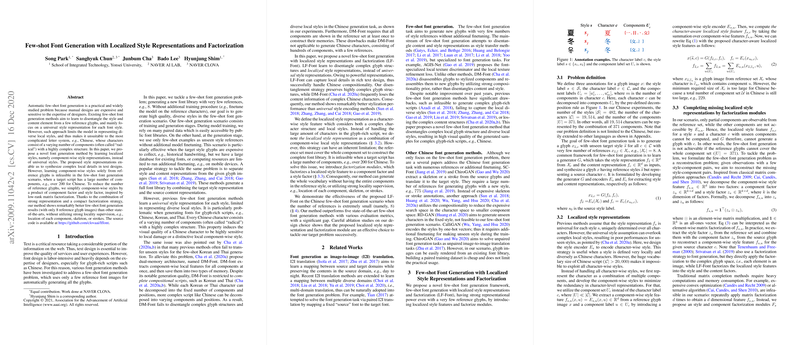Few-shot Font Generation with Localized Style Representations and Factorization
The paper entitled "Few-shot Font Generation with Localized Style Representations and Factorization" addresses the challenging task of automating font generation with a minimal number of reference images, a domain where prior methods had notable limitations particularly with scripts that exhibit complex glyph structures like Chinese. Traditional few-shot font generation techniques commonly adopt a universal style representation, failing to adequately capture diverse local styles within complex character compositions.
The novelty of this work lies in its introduction of localized style representations, which are defined as component-wise style features rather than universal style features. This approach facilitates synthesis of complex local details, which are crucial for scripts abundant in components, such as Chinese. Each character is a combination of several radicals, resulting in a glyph-rich and structurally intricate script. The authors propose representing styles in a component-wise manner instead of universally, arguing that this shift enables capturing the character's complex local variations.
This approach further employs factorization as an effective solution for the constrained scenario of few-shot learning. Specifically, the authors decompose component-wise style representations into a product of style and component factors, drawing inspiration from low-rank matrix factorization techniques. Such decomposition aids in achieving more flexible and powerful style encoding even with limited reference glyphs, overcoming the challenge of not observing specific components directly from references.
Quantitatively, the proposed LF-Font outperforms state-of-the-art models in the few-shot font generation domain. When evaluated on the challenging Chinese character set with merely eight reference glyphs, LF-Font demonstrates superior performance across various metrics including LPIPS, content and style accuracy, and FID. The results signify its capabilities in producing synthetically generated fonts that adhere closely to desired styles while faithfully preserving and reconstructing complex content structures. Noteworthy is the highlighted performance gap between LF-Font and competitor models, underscoring the efficacy of localized style representations and factorization in capturing intricate local characteristics.
Qualitatively, the model generates visually pleasing fonts that reflect subtle local features such as serif styles and stroke thickness, which are typically hard to maintain using previous methods. The major advantage of localized representation is evident in how it preserves intricate local styles and global compositionality, which are essential for generating fonts with high-fidelity aesthetics.
Future work could explore extending this methodology to an even broader range of typography, including handwritten styles or cursive scripts, where localized features are paramount. Additionally, potential directions include integrating advanced generative models such as adversarial or diffusion models to jointly enhance quality and diversity, or tuning the balance further between style adaptation and content preservation.
In conclusion, this research offers a compelling strategy by utilizing disentangled, localized style representations combined with factorization for few-shot font generation. This methodology not only elevates the ability to generate complex fonts with fewer samples but also highlights the importance of disentanglement in representation learning, setting a potential foundation for future advancements in AI-driven typography and graphic design.
